Helping Bereaved Children: 20 Activities for Processing Grief
Helping Bereaved Children: 20 Activities for Processing Grief
Copyrighted Article Re-Posted with Permission from authors Brad A. Imhoff, Kaela Vance and Amberle Quackenbush of Ohio University Presented to the 2012 All Ohio Counselors Conference in Columbus, Ohio
http://www.allohiocc.org/Resources/Documents/AOCC%202012%20Session%2062.pdf
Helping Bereaved Children: 20 Activities for Processing Grief
1. Thumball: A round ball is divided into sections with statements, words, or questions placed evenly around the ball. The ball is tossed around a circle and when people catch the ball they look under their right thumb to see which question is closest and answer that question. By using a Thumball, you are able to help children and adults alike open up and share information. For grieving children, this is especially important, because they may feel that no one understands why they are grieving. When they are able to share their thoughts and feelings, they can see that other children have experienced similar feelings as their own.
You can make your own Thumball out of any type of round ball (soccer, beach, foam, etc.). It can then be tailored to best fit your participants. You can have themes such as feelings, animals, values, icebreakers, entertainment, “Best-Worst-First”, etc. You can purchase pre-made
Thumball at http://thumball.com/.
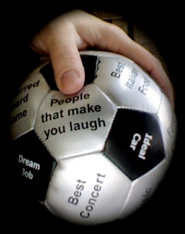
Thumbball Image
2. It’s My Life CD: For this activity you will need a plastic CD case and art supplies (e.g. markers/crayons, paper, stickers, any other craft items). The clients will create a CD of songs that describes how they view their lives, including the CD’s title, song list and cover design. You can use this activity to focus on a specific treatment theme, such as grief, anger, or sadness and it does not matter whether the songs are real or imagined. Processing questions can include asking about how the songs make them think or feel and why they chose to put them in their “My Life” CD. It is also important to acknowledge the uniqueness of their CD and discuss this concept as it pertains to the idea of change and growth.
3. Show & Tell: In individual sessions or especially in groups, have children bring in something connected to their loved ones to share with the counselor and/or the rest of the group. It could be something that was given to them by the loved one they lost, such as a favorite birthday gift. Alternatively, it could also be something that used to belong to the deceased, such as a father’s watch, a sister’s necklace, or a friend’s baseball glove. Having the child talk about this item and what it means to them allows the child to open up and delve deeper into their grief. In a group format, it will allow children to share memories and relatable feelings they are experiencing, which will help them feel less alone in the grieving process.
4. Message in a Bottle. Have children write a letter or draw a picture to their loved one who has died. Then, stick the note or picture in a bottle and seal it with a cork. You may choose to use the bottle as a metaphor and have the child take their bottle home for safekeeping. You may also choose to have the child send their bottle off in a body of water. You may also empower the child by allowing him/her to decide what should be done with their bottle. This activity can help children communicate the feelings they have for their loved one and the feelings that they are experiencing after the death they are grieving.
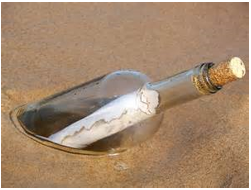
Bottle with Message
Materials: unmarked bottle, paper, writing utensils, cork
5. Recipe for Success: The materials needed for this activity include art supplies (such as paper, writing/coloring utensils and any other craft/scrapbooking items you desire). You will want to have the client brainstorm thoughts, emotions, feelings and behaviors that lead to success in finding happiness. They will want to create ingredients with quantities and instructions for cooking or baking. Processing topics could include:
Thoughts and feelings that emerged during the activity
Ingredients thought of that may have surprised the client
Discussing the most and last important steps in the recipe
How they decided on the steps/ingredients they chose
How others can help them finish the recipe (e.g. the role of counselor, family, teachers, etc.)
Tools needed to make the recipe
Other dishes that may work well with this recipe (i.e., adding “side” dishes)
Making changes to the recipe: when this may be necessary and what ingredients could be added.
6. Music. You can bring in age-appropriate music for children to listen to that may remind them of their loved one. Alternatively, you may have children/teens bring in their own songs or music videos that speak to them in their time of loss. It could be songs with lyrics that get at the emotions of loss (e.g., “What Hurts the Most” by Rascal Flatts), a favorite song of the deceased that reminds the child of him/her or a song the child and the deceased used to listen to together. The song can be listened to in session and then discussed in terms of what it means to the child, what thoughts come to mind, what emotions they experience, what memories come to them as a result of hearing it, etc. Essentially, have the child talk about what the song means to them and why it reminds them of their loved. This is also an activity that the child can do at home with family, as music may be more readily available there.
7. Kimochi Dolls: “Kimochi” means “feeling” in Japanese. These dolls can be found in different shapes (cat, octopus, cloud, bird, butterfly, etc.) and include little “feeling pillows” the child can put into a pouch of the animal. You can use these dolls as a way to connect, communicate, create and practice identifying feelings to help the children express themselves in a more positive manner. You can purchase Kimochi Dolls at
http://www.kimochis.com/main.html
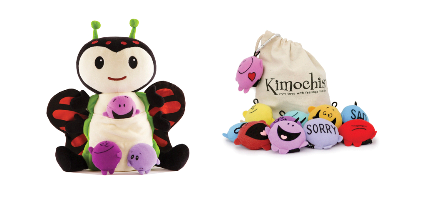
Kimochi Dolls
8. Feel Good File: For this activity you will need a manila file folder, paper, writing utensils (pencils, makers, crayons, etc.) and craft supplies. Children will first decorate the front of their file folders however they would like and then write something like “(Child’s Name)’s Feel Good File.” Then you want to have them begin creating documents for the file. Examples include:
- Ten positive qualities about yourself
- Three people you can ask to write a letter about five positive qualities you have (and have them collect the letters to add in the file). This can be homework for the next session or used in a family session.
- Have them collect any cards, letters and emails they have received that reflect positives about them to place in the file.
All of the documents should be reviewed with the idea of discussing thoughts and feelings that arise. This can be coupled with breathing activities to help the clients visualize their negative thoughts floating away and disappearing. Encourage the client to look through the file anytime they feel down.
9. Collaging: Creating a collage is often a way to help a child use free association. They see images that they like, cut them out and paste them on a college. They may also use photos of their own, cards they have received, letters they have written, anything they would like. They can have a specific purpose or theme for the collage or they can find and use anything they’d like. Afterward, ask the child to talk about what they chose to include and share what they see in their collage.
Materials: magazines, newspapers, photos, tape, glue. You can have additional materials if you’d like such as ribbons, markers, and other artistic items.
10. Grief Masks: The idea behind making a mask is that the child is hiding behind their true feelings and we want to help them bring out those hidden feelings and emotions in their artwork. They can create a mask from scratch out of Paper Mache or clay or they can use a pre- formed mask. By molding their own mask, the child can make it any shape they wish and then do the same with decorating.
Materials: Clay, Paper Mache, paint, markers, feathers, gems, glitter, ribbons, foam, etc.
11. Feelings Hide & Seek: To prepare for this activity, the counselor will prepare index cards with feelings written on them such as happy, sad, angry, scared, guilty, etc. For younger children, images of “feelings faces” could be used on the cards. These cards will be hidden around the room for the client to find. As the counselor, you will want to explain to the child that feelings can be hidden and we must find them in order to acknowledge them, so they can work through them. As children find a card, they should have the opportunity to discuss and process the feelings. The counselor may ask when they have felt the feeling and whether it was easy or hard to talk about. The children can designate someone they can talk to when they feel certain feelings and discuss why it is important to not keep feelings hidden. This can be utilized when discussing coping skills and it is important to validate and normalize the feelings the child is experiencing.
12. Brainstorming: This is an activity that is best suited for older children and it can be done in session or as homework. Ask children to write down, as fast as they can, as many characteristics or memories of the deceased person they can think of in ten minutes. If done in session, the list of what came to mind can then be talked through and discussed. If done as homework, they can be asked to do brainstorming for ten minutes every day or every other day. The idea is to get children to think intentionally about the lost loved one, what they appreciated, what they’ll miss, memories they’ll want to hang on to, even things they won’t miss. The memories and characteristics can vary in nature—happy, sad, angry, funny, scary, etc.—anything that comes to mind for the child.
13. Sending off Balloons: This activity is good for people of all ages. By releasing the balloons into the air, you are able to envision yourself sending a message to your loved one. It also symbolizes the release of your feelings and emotions. Children, friends and other family members can write messages on the balloons, the name of the loved one, etc. and then release them into the air. This can be done on a special day that is planned out like a celebration, an anniversary of something or whenever the child wants to send off their message.
14. Mancala Feeling Stones: For this activity all you need is a Mancala game. Children will first sort the colored stones and designate a feeling for each color (sad=blue, happy= green, angry=red, etc.). Then, they will pick up a stone and share an experience that corresponds with the color of their stone (such as a green stone=I feel happy when my mom buys me ice cream). Through this exercise, the clients can share their feelings using the colored stones to help in the process. This is also a good way to show it is acceptable and normal to have many emotions and feelings.
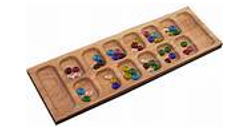
Mancala Game
15. Acrostic Poem: Have children write the names or nicknames of their deceased loved ones on a piece of paper. With each letter in the name, ask each client to write something he/she remembers about their loved ones. It could be characteristic of their loved one, a memory the child has of the person, something they used to do together, etc. Once it is completed and discussed, the child may want to tuck their poem inside a notebook or hang it in their bedroom as a keepsake.
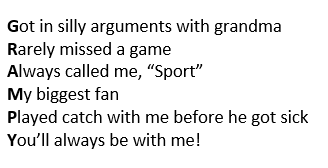
Acrostic Example
16. Where it hurts: This activity can help children express what they are feeling in their bodies, so that we as adults can understand them better. Even adults oftentimes find it hard to express how they are feeling and children experience this even more. This can be done on a normal-sized piece of paper (8 ½ x 11) or you can use craft paper and trace the child’s body on it. Then have the child draw all over the outline the feelings that they are having and where they might feel pain. Have the child try to write out feeling words as well.
Materials: paper, markers, pencils, crayons, paint, glitter, ribbons, stickers, gems, any other material for decorating.
17. Memory Box: For this activity, you will need a box and craft supplies (e.g. glitter, markers, paint, stickers, ribbons, paper, etc.). The counselor will explain to children that they are creating boxes they can fill with memories of their loved one. Children will take their boxes and decorate them any way they want, then take them home and fill them up with things that remind them of their loved one. They can pull out this box and look at its contents to remember their loved one. During the creating of the box, the counselor can ask questions about what types of things the client will put in the box and how they feel about the memories. This would be a good time to explain that a person can feel more than one feeling about a memory. Perhaps they are sad when they think about the memory because the loved one is gone, but since it is a happy memory they may feel that too.
18. Comparison Columns: This activity is designed for older children and helps them understand the potential complexity of grief and the wide variety of feelings it can include. Have them draw out two columns on a sheet of paper. They can label one column, “How I’ve Felt” and the other, “Why I Think I’ve Felt This Way.” Have them list all the different feelings they’ve experienced. This may be especially helpful for those who feel guilty about their feelings (for example, a child who feels anger toward his deceased mother). The child can list anger in the first column and then talk with the counselor about the origin of the feeling. Normalizing such feelings can help reduce the guilt that may be associated with experiencing it. Alternatively, columns may be titled, “What I Thought Grief Would be Like” and “What It’s Really Like” for those who are struggling with the grieving process.
19. Kisses for Heaven (Kisses for My Loved One): This is a way for a child to physically send kisses and hugs to a loved one. Ask the child unwrap the chocolate Hershey Kiss or Hug and put it on a special place (gravesite, memorial site, garden, etc.). When the child comes back, the kiss will have melted or been washed away, so they have indeed sent kisses to their loved one. Feel free to have the child eat the candy “kisses” and “hugs” as well—this can be a way for them to feel they are getting real kisses and hugs back from their loved one.
20. Scrapbooking: For this activity you will need scrapbooking supplies including a book to hold pages. The scrapbook can be used with various activities to explore the child’s feelings and help promote growth. This activity has potential to take up several counseling sessions. Memories and feelings about the loved one and family can be discussed and the counselor can also explore the child’s perspective and ability to organize his/her sense of self through creating a lifeline or story. To create a lifeline, children will draw a timeline of their life and important events including goals and accomplishments for the future. Each event should be discussed. The family can also help add to a lifeline or story session by adding narratives and forgotten even.
Heartfelt thanks to Brad Imhoff, Kaela Vance and Amberle Quackenbush of Ohio University for graciously giving permission to Hildegard Center to re-post this article for our project. The article was presentedto the 2012 All Ohio Counselors Conference in Columbus, Ohio.
